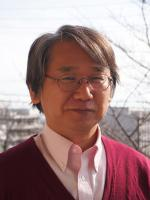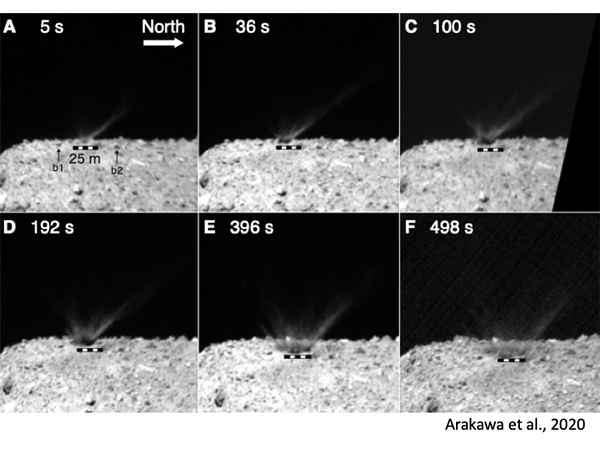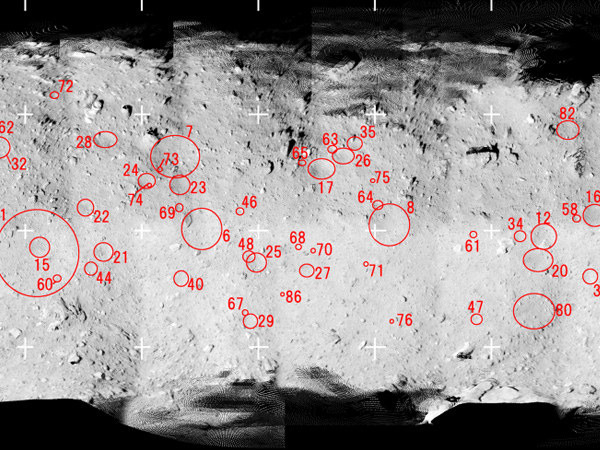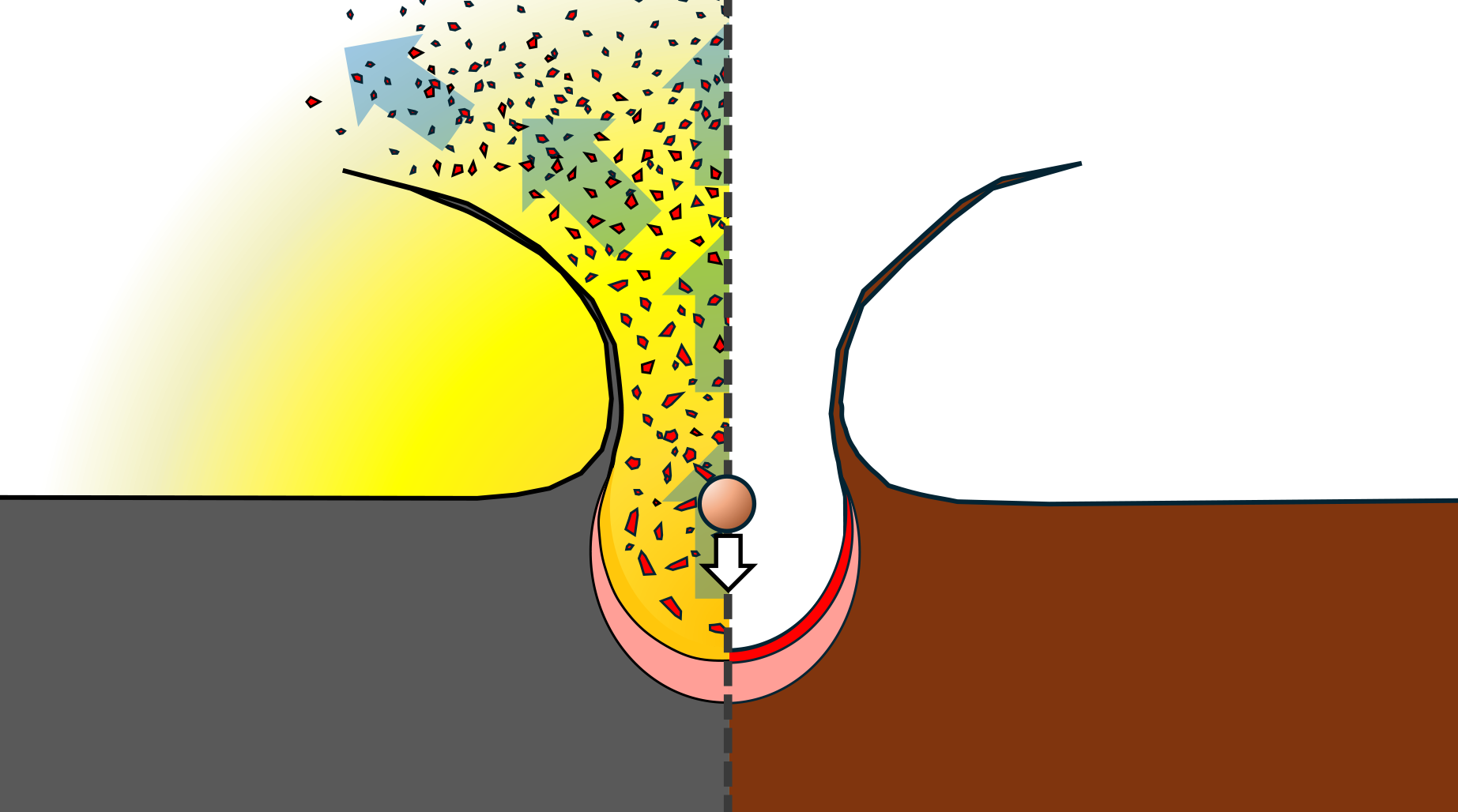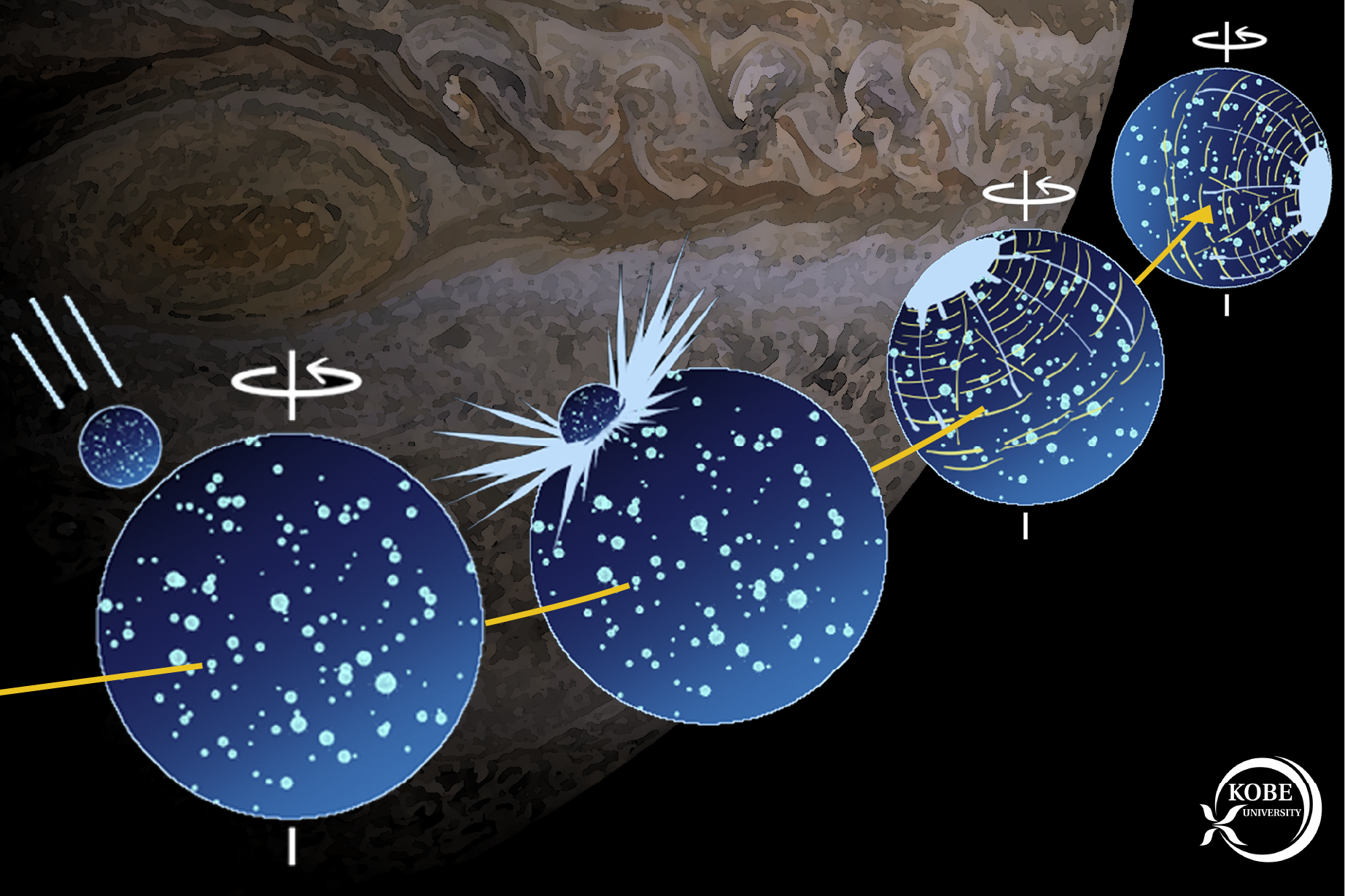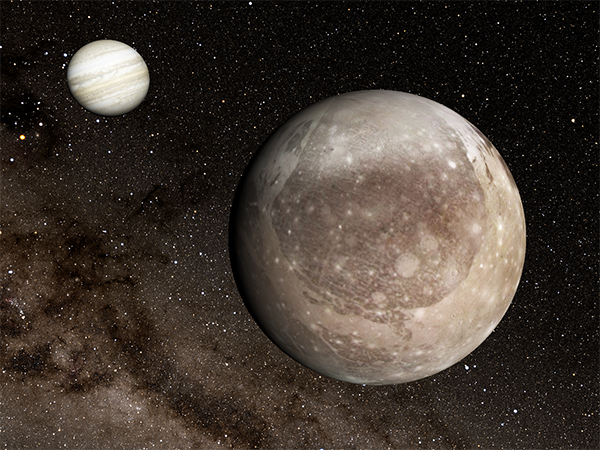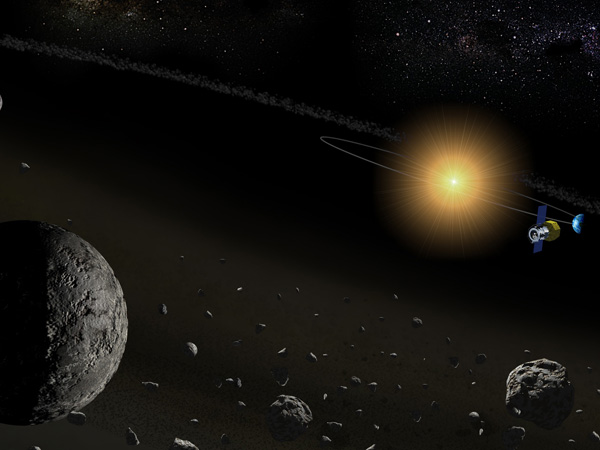A research group from Kobe University has demonstrated that the heat generated by the impact of a small astronomical body could enable aqueous alteration (*1) and organic solid formation to occur on the surface of an asteroid. They achieved this by first conducting high-velocity impact cratering experiments using an asteroid-like target material and measuring the post-impact heat distribution around the resulting crater. From these results, they then established a rule-of-thumb for maximum temperature and the duration of the heating, and developed a heat conduction model from this.
The research group consisted of the following members from Kobe University’s Graduate School of Science; Lecturer YASUI Minami, TAZAWA Taku (a 2nd year masters student at the time of research), HASHIMOTO Ryohei (then a 4th year undergraduate in the Faculty of Science) and Professor ARAKAWA Masahiko, in addition to JAXA Space Exploration Center’s Associate Senior Researcher OGAWA Kazunori (who was a technical specialist at Kobe University at the time of the study).
These results have expanded the spatial and temporal range over which the necessary conditions for aqueous alteration and organic solid formation could occur. This is expected to significantly increase the number of prospective astronomical bodies that could have brought water and the origins of life to Earth.
These research results were published in the British scientific journal Communications Earth and Environment (Nature Publishing Group) on May 18, 2021.
Main points
- The researchers used porous gypsum as an imitation asteroid and inserted multiple thermocouples (*2) inside it. They conducted high-velocity impact experiments on this target at impact speeds of 1km/s and over, and succeeded in measuring changes in temperature duration around the resulting crater soon after impact.
- This revealed that, regardless of the impact speed and projectile’s size and density, the maximum temperature and its duration were dependent upon dimensionless distance (the distance from the impact point scaled by the crater radius).
- Using the above results, the researchers calculated the temporal changes in thermal heat distribution after the crater’s formation on the asteroid’s surface. These calculations suggested that, at distances within 2 astronomical units (*3), aqueous alteration can occur if the crater has a radius of over 20km, and organic solid formation can be supported by craters of over 1km.
- These findings will enable an increased number of astronomical bodies to be considered as candidates for the source of the water and organic substances necessary for the beginning of life on Earth.
Research Background
It is believed that the water and organic substances necessary for life to begin on Earth were the result of a comet or asteroid impacting the planet. Minerals and organic substances that have experienced aqueous alteration have been discovered in meteorites (from which asteroids originate), providing proof that they once contained water. However, a heat source is necessary for the chemical reactions that cause aqueous alteration and organic solid formation inside asteroids.
One sufficiently strong heat source is the radioactive decay heating of 26Al (aluminum, *5), a short-lived radioactive nuclide found inside rocks. However, it is said that the radioactive heating that caused aqueous alteration and solid formation on asteroid parent bodies (*4) could have only occurred at the beginning of the solar system’s history due to the short half-life of 26Al (720,000 years).
In recent years, the theory that the impact heat generated when a small astronomical body hits an asteroid could also be a viable heat source has started to gain attention. However, it is not known how much heat is generated depending on the astronomical body’s characteristics (size, density, impact speed) and how far within the asteroid this generated heat is transmitted. Up until now, there have been no studies that have experimentally investigated this heat generation and propagation process to determine whether aqueous alteration and organic substance formation would be possible.
Research Methodology
This research group conducted laboratory experiments to investigate the relationship between the impact heat generated on an asteroid (as a result of a small astronomical body’s impact) and the impact’s characteristics. For the target, they used gypsum (a porous mineral composed of calcium sulfate dihydrate) to imitate an asteroid. They accelerated projectiles at the target at high impact velocities of between 1km/s to 5km/s using Kobe University’s two-stage horizontal gas gun (Figure 1). Multiple thermocouples were set in the gypsum target in order to measure the temperature changes post-impact. In this series of experiments, the researchers changed the size, density, impact speed of the projectiles and the thermocouples’ positions in order to investigate the differences in heat duration depending on the characteristics of the impact (Figure 2).
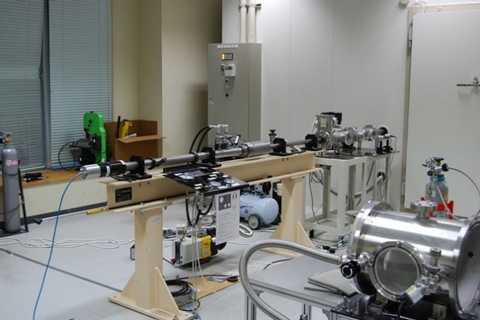
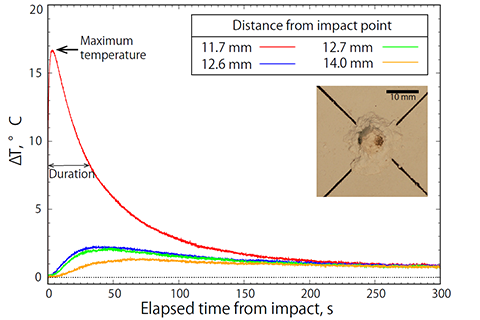
The x-axis indicates the elapsed time, with 0 being the time of impact. The y axis shows the differences in temperature from pre-impact onwards. This impact was made by an aluminum projectile with an impact velocity of 4.3km/s. The different colored lines indicate the distance between the point of impact and the thermocouples. The duration is the time that it takes for the maximum temperature to drop by half. The photo shows the impact crater. Thermocouples were embedded in the target.
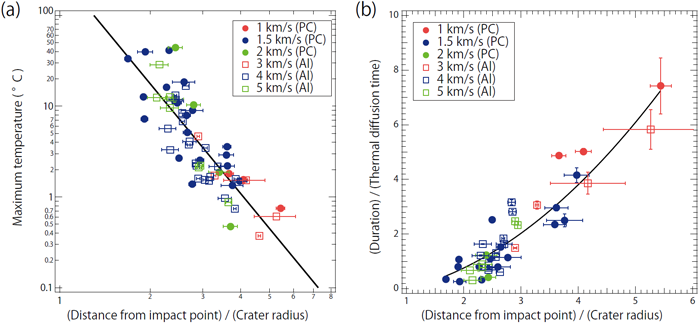
Duration is scaled by thermal diffusion (*6) time. The colors indicate different projectiles and impact speeds: PC is a polycarbonate sphere with a diameter of 4.7mm and Al is an aluminum sphere with a diameter of 2mm.
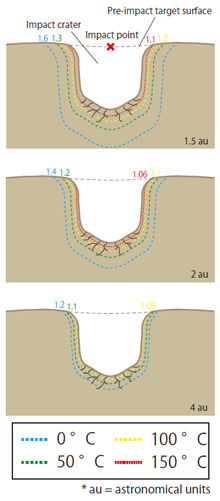
The dotted lines are isotherm contour lines. The numbers that meet the isotherm contour lines indicate the value obtained when normalizing the distance from the impact point by the crater radius.
From the heat duration graph, the research group investigated the maximum temperature and its duration, and looked at how this related to the impact characteristics (Figure 3). By using the dimensionless distance obtained by normalizing the distance from the impact point (where the projectile hit the target) by the crater radius, they successfully determined how maximum temperature and its duration are altered by impact characteristics and came up with a rule-of-thumb for this.
Subsequently constructing a heat conduction model incorporating this rule of thumb, enabled them to calculate the heat distribution around the crater formed on the asteroid surface (Figure 4). The research group checked the numerical results from the heat conduction model against data on the required heat and duration for aqueous alteration and organic solid formation obtained from past analyses of meteorites.
These results showed that aqueous alteration could occur if a crater with a radius of over 20km was formed within 2au from the Sun. In addition, they estimated that even a small crater with a 100m radius on an asteroid within 4au could heat up to 100°C, meaning that it could support organic solid formation. Most asteroids are located within 4au. The researchers also found that if a crater with a radius of over 1km is formed within 2au, the circumference of the crater can heat up to 0°C (the temperature at which ice becomes water), thus enabling organic solids to be formed.
Further Developments
It is thought that radioactive decay heating of 26Al triggers the chemical reactions for aqueous alteration and organic solid formation on asteroids. However, this heating can only occur near the core of comparatively large asteroids that are tens of kilometers in diameter. Furthermore, it is said that this could have only occurred within a million years after the Sun’s formation due to the short half-life of 26Al. On the other hand, collisions between asteroids still occur today, and it is possible that such collisions heat up the surface of even small asteroids, providing that the impact does not destroy the asteroid itself. In other words, these research results show that the potential for asteroids to support aqueous alteration and organic solid formation is temporarily and spatially far greater than previously thought. This will contribute towards an increased number of astrological bodies being considered as candidates that brought the water and organic substances for the beginning of life on Earth.
Next the research group hopes to examine samples returned from asteroid exploration missions conducted not only by Japan but other countries as well. If aqueously altered minerals or organic substances were to be discovered in the collected samples, this could provide evidence of impact heating’s effects.
Glossary
- *1 Aqueous alteration
- This refers to when the minerals inside a rock change as the result of a chemical reaction between the rock and water.
- *2 Thermocouple
- A heat sensor consisting of two rods, each made from different metals.
- *3 Astronomical units (au)
- The distance from the center of the Sun. One astronomical unit is the distance from the center of the Sun to Earth (approx. 150 million kilometers).
- *4 Asteroid parent bodies
- Astronomical bodies from which current asteroids originate. It is thought that asteroids are fragments that remain after the parent body was destroyed by an impact, or are an aggregation of fragments re-accumulated by gravity.
- *5 Radioactive decay heating of 26AI (a short-lived radioactive nuclide)
- A nuclide is a distinct kind of nucleus characterized by a specific number of protons or neutrons. Among these, nuclides that are energetically unstable emit radiation which causes them to become a different kind of nuclide called a radionuclide. The process whereby these nuclides emit radiation and eventually change type is called radioactive decay. During this process, energy is also emitted, generating heat. When 26Al decays it becomes 26Mg (magnesium) but the time that it takes for one half of the atomic nuclei in 26Al to decay (i.e. the half-life) is a relatively short 720,000 years.
- *6 Thermal diffusion time
- The estimated amount of time that it takes heat to be dispersed from the heat source. In this study this was calculated as (crater radius)2 / (thermal diffusion coefficient). The thermal diffusion coefficient is the matter’s characteristic value.
Acknowledgements
A portion of these experiments was performed in collaboration with the Hypervelocity Impact Facility at JAXA’s Institute of Space and Astronautical Science (ISAS). In addition, this research received funding from the following: a basic scientific research grant from the Sumitomo Foundation (research theme: ‘Measurements of post shock temperature after impact crater formation: Implications for thermal evolution of asteroids’, Principle Investigator: Yasui Minami), and JSPS KAKENHI grants JP16K17794 (Principle Investigator: Yasui Minami), JP16H04041 and JP19H00719 (Principle Investigator: Arakawa Masahiko).
Journal Information
- Title
- “Impacts may provide heat for aqueous alteration and organic solid formation on asteroid parent bodies”
- DOI
- 10.1038/s43247-021-00159-x
- Authors
- Minami Yasui 1, Taku Tazawa 1, Ryohei Hashimoto 2, Masahiko Arakawa 1, Kazunori Ogawa 3,1
- Kobe University Graduate School of Science
- Kobe University Faculty of Science
- JAXA Space Exploration Center
- Journal
- Communications Earth and Environment(Nature Publishing Group)


